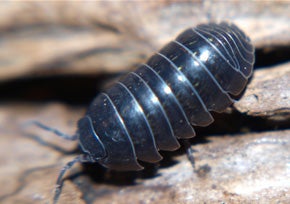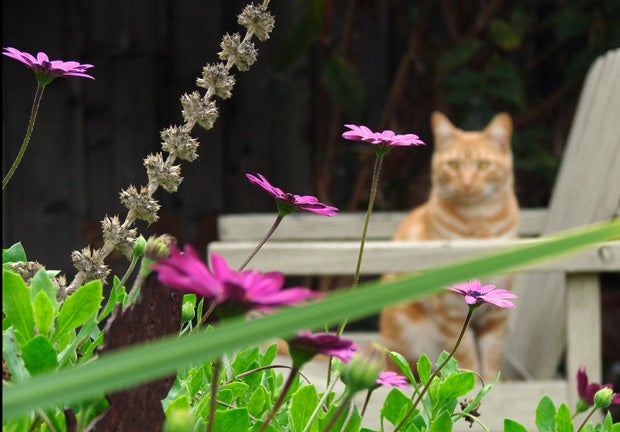Does beautiful honeysuckle have an ugly side?
ListenMike McGrath explains what rollie pollies are doing in your garden, how to compost horse manure properly, caring for your heat-damaged lawn, how to keep feral cats out of your garden, the best way to care for gardenias, and the many moods of honeysuckle. Plus: Mike speaks with Sally McCabe from The Pennsylvania Horticultural Society about how to create a school garden and keep it going!
Questions of the Week:
My wife had a black chain link fence installed to contain our two dogs. I think it looks God awful and want to cover it with something. My parents have been singing the praises of honeysuckle and just about had me convinced—until one of my coworkers rolled her eyes at me and explained that her honeysuckle had gone berserk and was now strangling all the other plants in her yard. So—who’s right?
— Justin in Roxborough, PA
I grew up in Northern New Jersey in the 1950s; a friend grew up in eastern PA in the 1970s. We both remember a honeysuckle that, when you pulled off the flower & sucked the end, you got a drop of nectar. The dreaded L. japonica doesn’t look like what we remember; and I don’t recall {quote} “our honeysuckle” as being invasive. I remember the flowers being white & yellow. Do you have any idea which honeysuckle this could be? We both want to plant it. Thanks!
— Karen, now in Perkasie, PA
Learn about the many faces of honeysuckle »
-

Photo by Flickr user Julie Falk
Highlights from show for June 22, 2013:
No more rollie pollies!
Janet in Oklahoma City, OK has had a 10×40 foot vegetable garden for six years, although it seems as if this year seems there are more rollie pollies than ever before! She is concerned because they are eating her strawberries and wants to stop them before it gets too bad. “If you have injury to your strawberries and you see rollie pollies or millipedes in there, the smart money says that something else did the original damage and they’re being opportunistic, like ants,” Mike says. There may be so many of them this year because of the frequent dry spells followed by heavy moisture, the latter of which is highly attractive to these pests. There is a simple organic control known as Diatomaceous earth (DE), which can be dusted around the plants that she is currently seeing the rollie pollies around. “As long as the Diatomaceous earth stays dry,” Mike advises, “it will desiccate any creature… that tries to cross over it.”
“If you have injury to your strawberries and you see rollie pollies or millipedes in there, the smart money says that something else did the original damage and they’re being opportunistic, like ants.”
Mike McGrath
-

Photo by Flickr user thefixer
Using Horse Manure
From French Creek State Park in PA, James wanted to know the best way to use his large supply of horse manure. The manure does contain sawdust from the stalls, however, so he wants to know if it is still worth using. Compostable manure contains the stable sweepings of liquid and solid waste and bedding, and as long as he uses it correctly, will be a huge benefit to his garden. While the compostable horse manure is not compost in of itself, it is ready to use for sweet corn plants and lawns. “You spread well composted horse manure on your lawn in the fall and your lawn will get up and kiss you on the lips!” Mike explains. When it comes to the raw manure, it is best used on non-fruiting plants that crave nitrogen, but for a plant like strawberries, for example, it can stimulate an extremely large plant that only bears a few fruits on it. The remaining manure that James has can be mixed with his general compost to create a balanced fertilizer for his garden.
Special guest: Sally McCabe
Sally McCabe, Project Manager of the Pennsylvania Horticultural Society’s Green City Teachers Program, joins Mike on the show to talk about building a school garden. Although the year for garden seasons tends to be the polar opposite of the academic school year, the Green City Teachers Program is an inclusive program that draws from the support of teachers, students, and community members to build and sustain school gardens in the Philadelphia area to add to the approximately 300 that already exist. As McCabe explains, having horticultural opportunities at school is a way of “crossing lines” to incorporate learning material from science, art, math, and horticulture. “Getting the kids away from the classroom and out into some fresh air where they can touch some plants, play in the dirt, look at worms, an maybe a eat a little bit of what they’ve grown just brings out a whole different side of the kids-and the teachers!” she says. Many of the schools do not have a lawn that is available for any gardening, which is why the Green City Teachers program incorporates information on how to build a raised garden bed on the blacktop and testing soils. Teachers in the program also are given expert advice on “how to make things grow when you’re in terrible, horrible, physical makeups that are our school yards.”
PHS has a library of various gardening curriculum, books, and videos of different horticultural plans for areas all around the country. “Obviously you do have to design a curriculum for your climate,” Mike says. “Pretty much every state in the country has a dedicated university that has an extension service and every county should theoretically have an extension agent.” McCabe runs a two-day extensive training for teachers where they can walk away with lesson plans and learn how to incorporate other subjects into their gardening lesson. In it’s essence, the program is about learning how to “cross all these lines so that the teachers and the kids can come out of their normal, comfortable envelopes and really shine,” McCabe says. The program will be held Wednesday June 26 and Thursday June 27. Preregistration is required and can be accessed at www.phsonline.org
Slideshow below: School gardens
Helping a heat damaged lawn
Doug in Saint John’s, Florida wants to know the best method for caring for his grass. In Doug’s hot climate, he has warm season grass which is best cared for by watering it once a week in the morning. “In extreme situations, which obviously you will get extreme over the summer- deeply watering twice a week might be a good idea but never more than that,” Mike says. In addition he recommends Doug provide the lawn three gentle, natural, and organic feedings in the course of time when the lawn is green, “but those long deep waterings are your best protection against weeds.”
Keeping feral cats out of your garden
Jackie from Philadelphia, Pennsylvania has a problem with feral cats using her garden as a litter box. She has been proactive in taking the cats to the SPCA to be neutered and checked for feline leukemia to keep the population controlled and in good health, but doesn’t know how to keep them out of her gardening space. Mike laments that this is a common problem and cautions that even healthy cats introduce parasites to a vegetable garden. He advises that she should wear gloves when working in the soil as this is where Jackie would be most vulnerable to these parasites. To keep the cats at bay, Mike recommends installing a motion-activated sprinkler. Another option would be to roll out chicken wire over her gardening area before planting; if cats aren’t able to dig in the garden, they will move on. Mike explains how to garden around chicken wire by planting seeds in the holes of the wire and using tin snips to cut out areas to install larger seedlings like tomatoes or peppers.
-

Photo by Flickr user Dawn Ellner
Appeasing your gardenia
Barbara from Bucks County, Pennsylvania received a gardenia bush as a gift, but the plant did not come with care instructions. Mike laughed and said: “We get these calls like once or twice a year of someone giving someone a gardenia as a gift. And I have to be honest, my first thought is, Oh, don’t they like you? Because it’s like the biggest drama queen diva coming to stay with you for a week — you know nothing you do is gonna be even vaguely acceptable. They are very finicky plants.” Mike went on to explain that these plants prefer highly acidic soil. Since Barbara is planning to transfer the plant to a larger pot, Mike recommends filling the new pot with a mixture of peat moss and compost to create naturally rich soil. Once repotted, the plant should be positioned in a dappled bright light rather than direct sunlight. These basic conditions should keep the plant happy, but Mike further recommends contacting the plant company that made the shipment to try to get a hold of the care instructions for the specific species of gardenia that she received.
-
Photo by Flickr user Mauricio Mercadante
“We get these calls like once or twice a year of someone giving someone a gardenia as a gift. And I have to be honest, my first thought is, Oh, don’t they like you? Because it’s like the biggest drama queen diva coming to stay with you for a week — you know nothing you do is gonna be even vaguely acceptable. They are very finicky plants.”
Mike McGrath
— This week’s post was written by Jolie Higazi, You Bet Your Garden Intern
WHYY is your source for fact-based, in-depth journalism and information. As a nonprofit organization, we rely on financial support from readers like you. Please give today.







